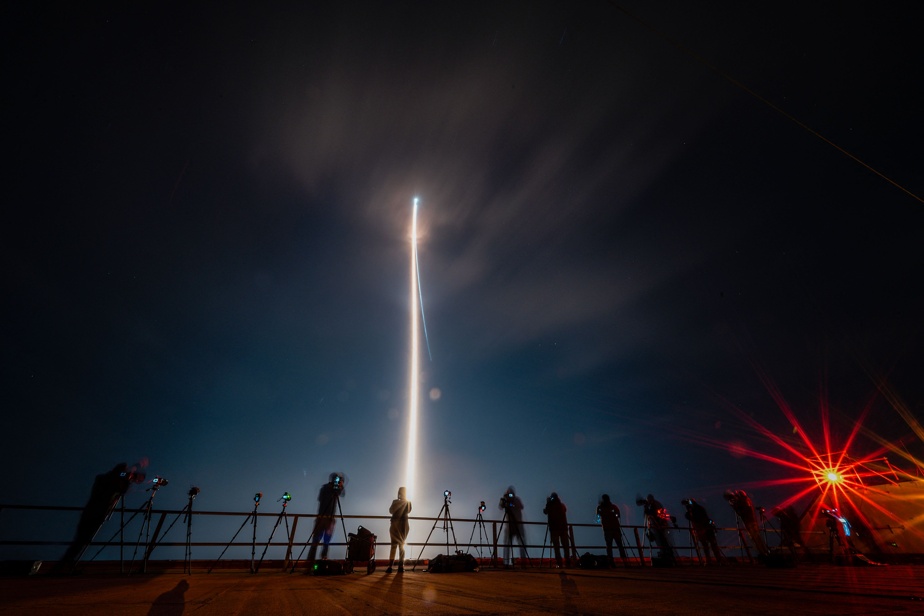(Cape Canaveral) A brand new rocket took off from Florida on Monday, with on board the first American device to attempt to land on the Moon in more than 50 years, this time developed by a private company.
The Vulcan Centaur rocket from the ULA industrial group, which brings together Boeing and Lockheed Martin, made its first flight from Cape Canaveral, tearing off from the ground at 2:18 a.m. Monday.
Base personnel applauded and shouted with joy at the separation of the launcher and the lunar spacecraft after some 48 minutes without incident, a key milestone for the private firm.
ULA CEO Tony Bruno said he was “excited” on the NASA Broadcast Network. “It represents years of hard work […] so far it’s been a wonderful mission back to the moon,” he added.
An “impeccable” launch for Eric Monda, ULA’s director of strategic planning. “It was so good, I rushed outside to watch,” he said.
The lander on board, named Peregrine, was developed by the start-up Astrobotic, with the support of NASA, which commissioned this company to transport scientific equipment to the Moon – a contract worth $108 million.
The launch should inaugurate a series of missions supported by the American space agency, which wishes to rely partly on the private sector for its lunar ambitions.

PHOTO JOE SKIPPER, REUTERS
If Astrobotic manages to land on the Moon as planned on February 23, it could become the first company to achieve this feat.
In recent years, Israeli and Japanese companies have attempted to land on the moon, but these missions ended in crashes.
“Leading America’s return to the surface of the Moon, for the first time since Apollo, is a tremendous honor,” Astrobotic boss John Thornton said at a press conference on Friday. However, he said he was aware of the difficulty of the task and the risks of failure.
After the separation between the launcher and the lunar craft, Astrobotic must power up the Vulcan Centaur rocket and attempt to establish communication. If all goes well, the lander will then continue its route towards our natural satellite.
Once in lunar orbit, the probe will wait until the lighting conditions are right to attempt to land.
The targeted landing site is located on the visible side of the Moon, near mysterious domes formed by lava, but which scientists struggle to explain.
Thanks to the instruments shipped, NASA must study the composition of the surface, as well as the radiation.
Human ashes
The mission has also caused controversy because it carries the ashes or DNA of dozens of people, including those of the creator of the popular science fiction television series Star Trek, Gene Roddenberry, as part of a partnership with the Celestis company, specializing in “commemorative spaceflights”.
Sending these ashes to the Moon aroused the anger of the Navajo Native American tribe, which denounced the “desecration of a sacred place” for “many Native American cultures”, without however obtaining the postponement of the launch.
Vulcan Centaur, in development for around 10 years, represents “the future of the company”, underlined Mark Peller, vice-president of the ULA group.
The rocket, which measures around 60 meters high, should allow it to replace its Atlas V and Delta IV launchers, and to compete with SpaceX with more affordable takeoffs.
ULA, which plans six Vulcan Centaur launches this year, wants to recover its engines after each flight to further increase the profitability of its activities.
Lunar economy
If NASA is not at the heart of this mission, it nonetheless represents a major step for the agency, which seeks to encourage the development of a lunar economy.
It has therefore signed a contract with several companies, including Astrobotic, to send scientific equipment to the Moon. The program, called CLPS, provides companies with crucial financing.
Another selected company, Intuitive Machines, is also scheduled to launch for the Moon in mid-February with a SpaceX rocket.
This new strategy should allow NASA “to make the trip more often, faster and cheaper,” explained Joel Kearns, a senior official within the space agency.
These missions studying the lunar environment should make it possible to prepare for the return of astronauts to the Moon, which NASA is planning with its Artemis program.
To date, only the United States, the Soviet Union, China and India have successfully landed a device on the Moon.
A mission from the Japanese space agency (Jaxa) is also due to attempt to land on the moon in about two weeks. Russia, for its part, spectacularly missed a moon landing this summer.
